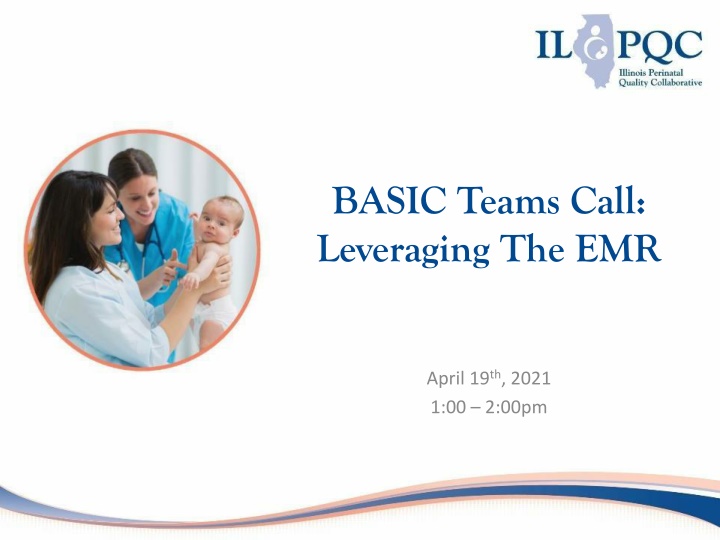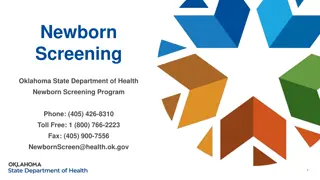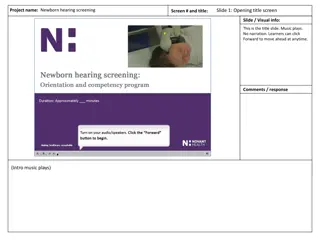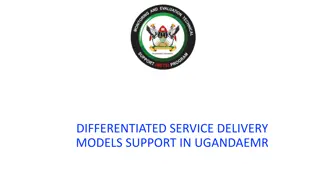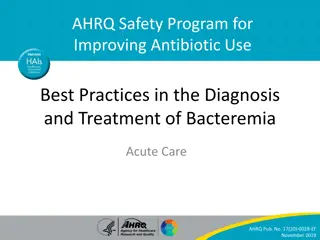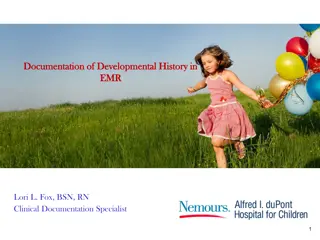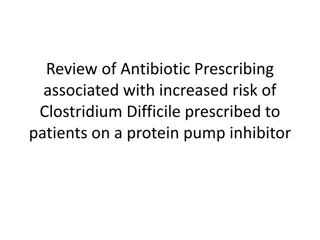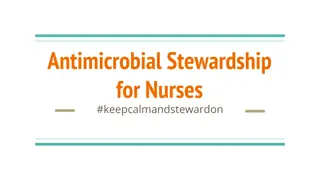Leveraging EMR for Improved Newborn Antibiotic Initiatives
This presentation focuses on leveraging Electronic Medical Records (EMR) in achieving the objectives of the ILPQC BASIC Vision. It includes discussions on summarizing EMR utility in BASIC, reviewing EMR data structures, showcasing examples of EMR builds contributing to BASIC aims, and outlining key driver diagrams for implementing best practices in newborn antibiotics initiatives.
Download Presentation

Please find below an Image/Link to download the presentation.
The content on the website is provided AS IS for your information and personal use only. It may not be sold, licensed, or shared on other websites without obtaining consent from the author.If you encounter any issues during the download, it is possible that the publisher has removed the file from their server.
You are allowed to download the files provided on this website for personal or commercial use, subject to the condition that they are used lawfully. All files are the property of their respective owners.
The content on the website is provided AS IS for your information and personal use only. It may not be sold, licensed, or shared on other websites without obtaining consent from the author.
E N D
Presentation Transcript
BASIC Teams Call: Leveraging The EMR April 19th, 2021 1:00 2:00pm
Objectives from Todays Call Summarize EMR utility in BASIC Review EMR data structure and reporting Showcase examples of EMR builds that will contribute to achieving BASIC AIMS 2
ILPQC BASIC Vision: ILPQC hospitals, regardless of perinatal level or past experience with implementing newborn antibiotics initiatives, will implement best practices to provide: the right antibiotics for the right babies for the right duration AIMs: Decrease by 20% (or absolute rate of 4%) the number of newborns, born at 35 weeks who receive antibiotics Decrease by 20% the number of newborns with a negative blood culture who receive antibiotics for longer than 36 hours
Data Entry & Reporting Clinical Decision Support 4
BASIC Key Driver Diagram AIMS Change Ideas Primary Drivers Create multidisciplinary antibiotic stewardship QI team Educate healthcare team on best practices Provide standardized education and anticipatory guidance with focus on equitable care to families on EOS and treatment plan By June 2022, ILPQC Hospitals will: Implement QI infrastructure Monitor & share transparent antibiotic data A. Decrease by 20% (or absolute rate of 4%) the number of newborns, born at 35 weeks who receive antibiotics Coordinate with IT to implement reporting system from EMR Review transparent data and debrief with providers Initiate timely and appropriate antibiotics Standardize risk assessment for early onset sepsis (EOS) Communicate with OBs to share maternal risk for EOS Implement protocols for serial assessment with response to worsening status B. Decrease by 20% the number of newborns with a negative blood culture who receive antibiotics for longer than 36 hours Consistently obtain blood cultures Partner with inpatient lab to process blood culture results De-escalate therapy based on culture and sensitivity results Implement pharmacy protocols to assure appropriate use Standardize dosing guidelines and order sets Implement process to discuss antibiotic duration and course Implement automatic stop order processes Administer and de- escalate antibiotics Deliver equitable care Review health quality data stratified by race, ethnicity, and Medicaid status to identify disparities and address opportunities for improvement Version 2.12.2021
BASIC Key Driver Diagram AIMS Change Ideas Primary Drivers Create multidisciplinary antibiotic stewardship QI team Educate healthcare team on best practices Provide standardized education and anticipatory guidance with focus on equitable care to families on EOS and treatment plan By June 2022, ILPQC Hospitals will: Implement QI infrastructure Monitor & share transparent antibiotic data A. Decrease by 20% (or absolute rate of 4%) the number of newborns, born at 35 weeks who receive antibiotics Coordinate with IT to implement reporting system from EMR Review transparent data and debrief with providers Initiate timely and appropriate antibiotics Standardize risk assessment for early onset sepsis (EOS) Communicate with OBs to share maternal risk for EOS Implement protocols for serial assessment with response to worsening status B. Decrease by 20% the number of newborns with a negative blood culture who receive antibiotics for longer than 36 hours Consistently obtain blood cultures Partner with inpatient lab to process blood culture results De-escalate therapy based on culture and sensitivity results Implement pharmacy protocols to assure appropriate use Standardize dosing guidelines and order sets Implement process to discuss antibiotic duration and course Implement automatic stop order processes Administer and de- escalate antibiotics Deliver equitable care Review health quality data stratified by race, ethnicity, and Medicaid status to identify disparities and address opportunities for improvement Version 2.12.2021
Partnering with IT Anticipating Challenges Opaque change management process How to even get started? Limited resources (and competing priorities) within IT IT jargon Analyst = your friend in IT who will be doing the building Validate build IT Environments: PRD or Production = the EMR system that you use every day Dev or POC = the part of the system where changes are built TST or TEST = the part of the system where changes are tested 7
DATA ENTRY AND REPORTING 8
BASIC Reporting Monthly Hospital Data Form (Structure Measure) Hospital-Level Newborn Data Monthly Newborn Data Forms (Process Measure) Patient-Level: Data collection is resource intensive, especially with high volume hospitals. 1. Identify Eligible Patients (Newborn Form Data Collection Instructions) 2. Audit Patient-Level Data Identify EMR Gaps Organize Notes for Data 3. Generate Reports! 9
BASIC Reporting Monthly Hospital Data Form (Structure Measure) Hospital-Level Newborn Data Monthly Newborn Data Forms (Process Measure) Patient-Level: Data collection is resource intensive, especially with high volume hospitals. 1. Identify Eligible Patients (Newborn Form Data Collection Instructions) 2. Audit Patient-Level Data Identify EMR Gaps Organize Notes for Data 3. Generate Reports! 10
2 - Audit Patient-Level Data Match data form questions to data source On Paper (SBAR, signout sheets) In the EMR For example: In nursing flowsheets In lab results ??? Not in the chart 12
2 - Audit Patient-Level Data (Fill in Data Gaps) Modify the EMR to capture any missing data Flowsheet for RN documentation Note template for MD documentation 13
2 - Audit Patient-Level Data (A Note on Note Templates) Free Text = Manual Chart Review Discreet = Reportable Free Text Discreet: Selection matches data form and is saved in a discreet form for reporting 14
3 - Generate Reports! All EMRs have capability of generating reports; the process of building reports varies by institution Most hospital systems have a dedicated team responsible for data reporting that might be separate from the IT team (Data Analytics, Enterprise Data Warehouse) Key takeaways Ensure the answer to every data form question exists in your EMR Make data discreet to the extent possible to enable reporting Work with your hospital s data analytics team to create reports 15
CLINICAL DECISION SUPPORT 16
Adopt A Risk Assessment Tool Our Example 17
Make Your Risk Assessment Tool Easy To Find Add a link to a protocol or to the Kaiser EOS website into admission or antibiotic order sets Using Epic & Using NEOSC? Turn on the built-in NEOSC based on the Kaiser EOS calculator! Auto-populates risk factors from data in the maternal chart. Recommendations can be displayed in patient lists and within the patient s chart 18
Epic Early-Onset Sepsis Calculator (Based on Kaiser NEOSC) 19
Order Sets With Kaiser NEOSC Use order sets to translate recommendations into clinical practice 20
Order Sets A group of orders that standardizes & expedites the ordering process for a common clinical scenario Reduce variation in care Align clinical practice with BASIC AIMS Educate healthcare team on best practices 21
Order Sets With NEOSC Link to Kaiser calculator
Order Sets With NEOSC Vital Sign Frequency Based on Kaiser EOS
Order Sets With NEOSC Serial Assessment Protocols
Order Sets With NEOSC Standardized Antibiotic Dosing
Order Sets With NEOSC Default Stop Times
Order Sets With NEOSC Blood Culture Best Practices
Order Sets With Risk Assessment Tools Risk Categorization Tool for Infants <35 weeks GA
RECAP- EMR Process Discovery phase Brainstorming phase Partnership phase 30
RECAP- EMR Partnership Process Identify IT person for partnership Share project plan and create assignments for departments QI team continues with BASIC work IT and analytics team builds EMR changes Feedback loop QI team reviews draft/proposed changes QI teams and clinical staff provide feedback Feedback incorporated and final review provided EMR changes rolled out and staff education 31
